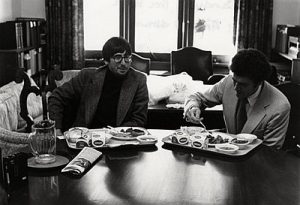New Acquisition: Incunable Leaf
After the advent of movable type in Western Europe, books increasingly became printed works instead of labor-intensive manuscript copies. Printed books produced during this early period of print are commonly called “incunabula,” Latin for “swaddling clothes” or “cradle,” which references the technology’s period of infancy. The period conventionally encompasses works printed before 1501.
Special Collections and University Archives has added an incunable fragment to its collection of materials suitable for teaching and studying the history of the book. This new acquisition is a leaf from the fifteenth century edition of Arbor vitae crucifixae Jesu Christi (ISTC iu00055000) written by the Franciscan Ubertinus de Casali (1259-1329). Ubertino was an outspoken critic of the pontificate and wrote this text after being banished by Pope Benedict XI (1240-1304) from preaching at Perugia. The text espouses a strict interpretation of the Rule of St. Francis and critiques the Franciscan Order for not adhering to an extreme state of poverty.




 Name: Eito Okino
Name: Eito Okino